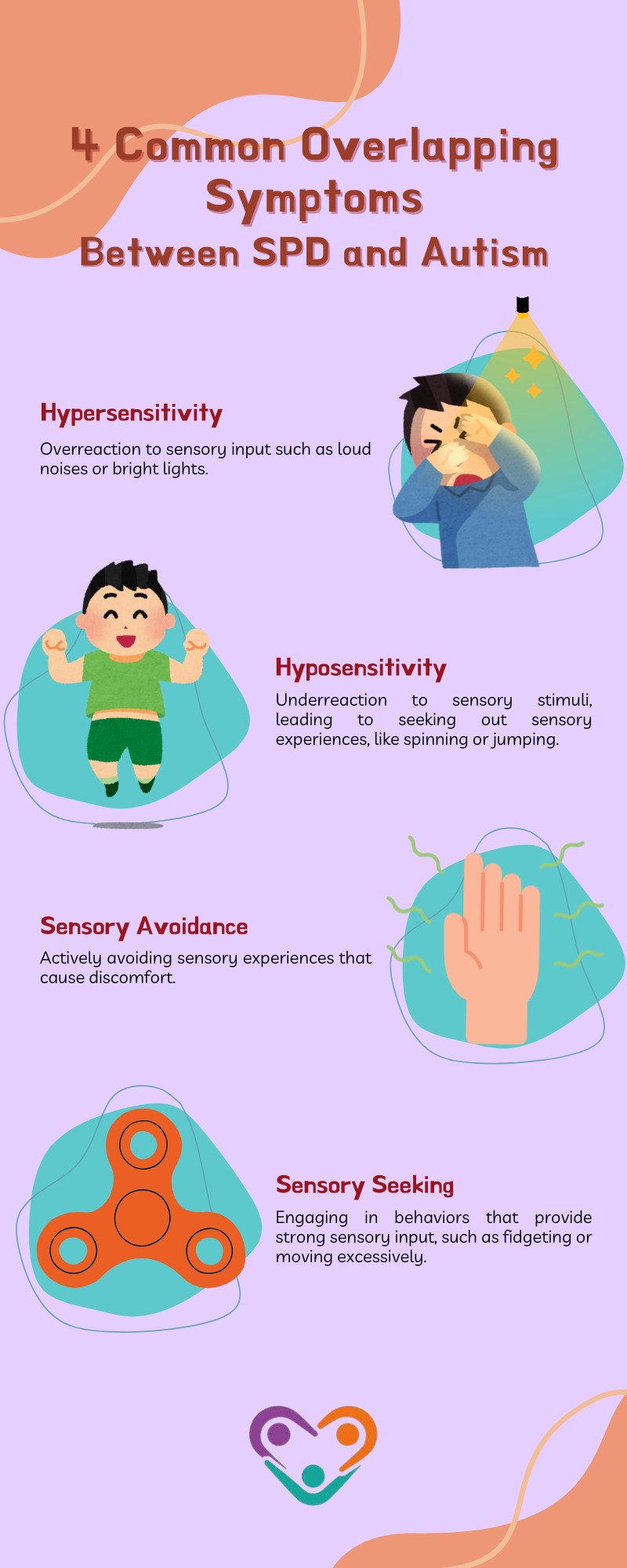Sensory Processing Disorder (SPD) is a condition where the brain has difficulty receiving and responding to sensory information. It affects how individuals perceive and react to various stimuli from their environment, including sights, sounds, textures, and movements.
A person with sensory processing disorder may experience over-sensitivity (hypersensitivity) or under-sensitivity (hyposensitivity) to sensory input, which can lead to challenges in daily activities and interactions.
Is SPD a Part of Autism?
Yes, sensory processing disorder is not officially considered a core part of autism, but it is very commonly associated with it. Many autistic individuals experience sensory challenges that overlap significantly with the symptoms of SPD.
These sensory processing difficulties are actually recognized in the diagnostic criteria for autism spectrum disorder under the DSM-5, which includes “hyper- or hypo-reactivity to sensory input” as a possible characteristic.
However, SPD on its own is not exclusive to autism. A person can have sensory processing issues without being autistic, and vice versa. While SPD and autism often coexist, they are not the same condition. The connection between autism and sensory processing challenges is important to understand. While autism covers a wide range of social, communication, and behavioral differences, sensory processing disorder (SPD) focuses specifically on difficulties with processing sensory input. This overlap means many autistic children face daily struggles with overstimulation. To learn more about how these sensory challenges affect their everyday lives, check out How Overstimulation Impacts Children with Autism Daily.
5 Common Symptoms of Sensory Processing Disorder
The symptoms of sensory processing disorder can vary widely among individuals. Here’s a breakdown of common symptoms categorized by sensory type:
- Tactile: Avoidance of certain textures, discomfort with clothing labels, excessive reaction to light touch
- Auditory: Overreaction to loud sounds, difficulty filtering background noise, preference for quiet spaces
- Vestibular: Fear of movements like swings or slides, excessive spinning, seeking out constant movement
- Proprioceptive: Clumsiness, seeking heavy pressure on the body, difficulty with body awareness in space
- Visual: Sensitivity to bright lights, difficulty focusing on tasks, avoidance of visually busy environments
Understanding these symptoms is crucial for parents and caregivers of individuals who may have SPD, especially as they often overlap with other conditions like autism. By recognizing these signs, they can better support and advocate for appropriate interventions and resources.
Relationship Between Sensory Processing Disorder and Autism
Understanding the connection between sensory processing disorder and autism is crucial for parents and caregivers. SPD can manifest in individuals with autism, but the prevalence and nature of this relationship need careful examination.
Research indicates that a significant number of individuals diagnosed with autism also experience symptoms related to SPD. Studies have shown varying results regarding the prevalence of SPD among those on the autism spectrum.
These statistics highlight that many individuals with autism experience sensory processing challenges, which can impact their daily functioning and overall quality of life.
Individuals with both autism and SPD often exhibit overlapping sensory symptoms. These may include heightened sensitivity to certain stimuli, difficulty in filtering sensory information, and unusual responses to sensory experiences.
Common overlapping symptoms include:

Recognizing these overlapping sensory symptoms is vital as they can inform strategies for support and intervention. Understanding whether SPD is a component in an individual’s autism can greatly influence how they are supported in thriving environments.
Treatment and Management
Addressing sensory processing disorder within the context of autism requires a multi-faceted approach. Various therapeutic methods can help manage SPD symptoms in individuals with autism. Some of these approaches include:
- Occupational therapy
- Sensory integration therapy
- Behavioral therapy
- Art and music therapy
- Social skills training
These therapeutic approaches aim to help individuals with autism learn to process sensory information more effectively, leading to improved overall functioning.
Recognizing that every individual with autism is unique, the importance of individualized interventions can’t be overstated. Each person’s sensory preferences, sensitivities, and responses require tailored strategies for effective management.
Individualized interventions enhance the effectiveness of treatment plans, fostering better outcomes for those with both SPD and autism. This tailored approach ensures that the support provided aligns with the individual’s specific sensory processing needs.
Supporting Individuals with Autism and SPD
Creating supportive environments and collaborating with healthcare providers are essential strategies for aiding individuals with autism and SPD. These approaches can help enhance their quality of life and overall functioning.
A sensory-friendly environment is tailored to minimize sensory overload and provide comfort for individuals with autism and SPD. Here are some things to consider when designing such spaces:
- Use natural light or soft, adjustable lighting; avoid harsh fluorescent lights that can be overwhelming.
- Incorporate soundproofing materials; consider white noise machines or soft music to mask disruptive sounds.
- Provide a variety of textures; include soft cushions, calming blankets, and tactile toys for interaction.
- Keep spaces organized and clutter-free; use calming colors and simple patterns to reduce visual overstimulation.
- Designate quiet zones where individuals can retreat to regroup when feeling overwhelmed.
Creating these sensory-friendly areas can foster a sense of safety and help individuals manage their sensory sensitivities effectively.
Collaboration with healthcare professionals is also vital for supporting individuals with autism and SPD. Parents and caregivers should work closely with various specialists to develop comprehensive management plans.
Implementing these strategies can significantly benefit individuals with autism and SPD, helping them navigate their environments and daily life more effectively.

Conclusion
While Sensory Processing Disorder is not officially part of autism, the two often go hand in hand. Many autistic individuals experience sensory challenges that mirror SPD, making it essential to understand how these conditions overlap.
Recognizing the signs of SPD, especially in the context of autism, can lead to more effective support and personalized care. At Golden Care Therapy, we provide high-quality ABA therapy in Georgia, New Jersey, Indiana, New York, and Florida. Our team of experienced therapists focuses on building meaningful connections, promoting growth, and helping children thrive in everyday environments. We believe every child deserves compassionate, evidence-based care that truly makes a difference. If you’re looking for dedicated support and professional guidance, reach out to us today. Contact us now to learn how we can help your child reach their full potential.
Sources:



